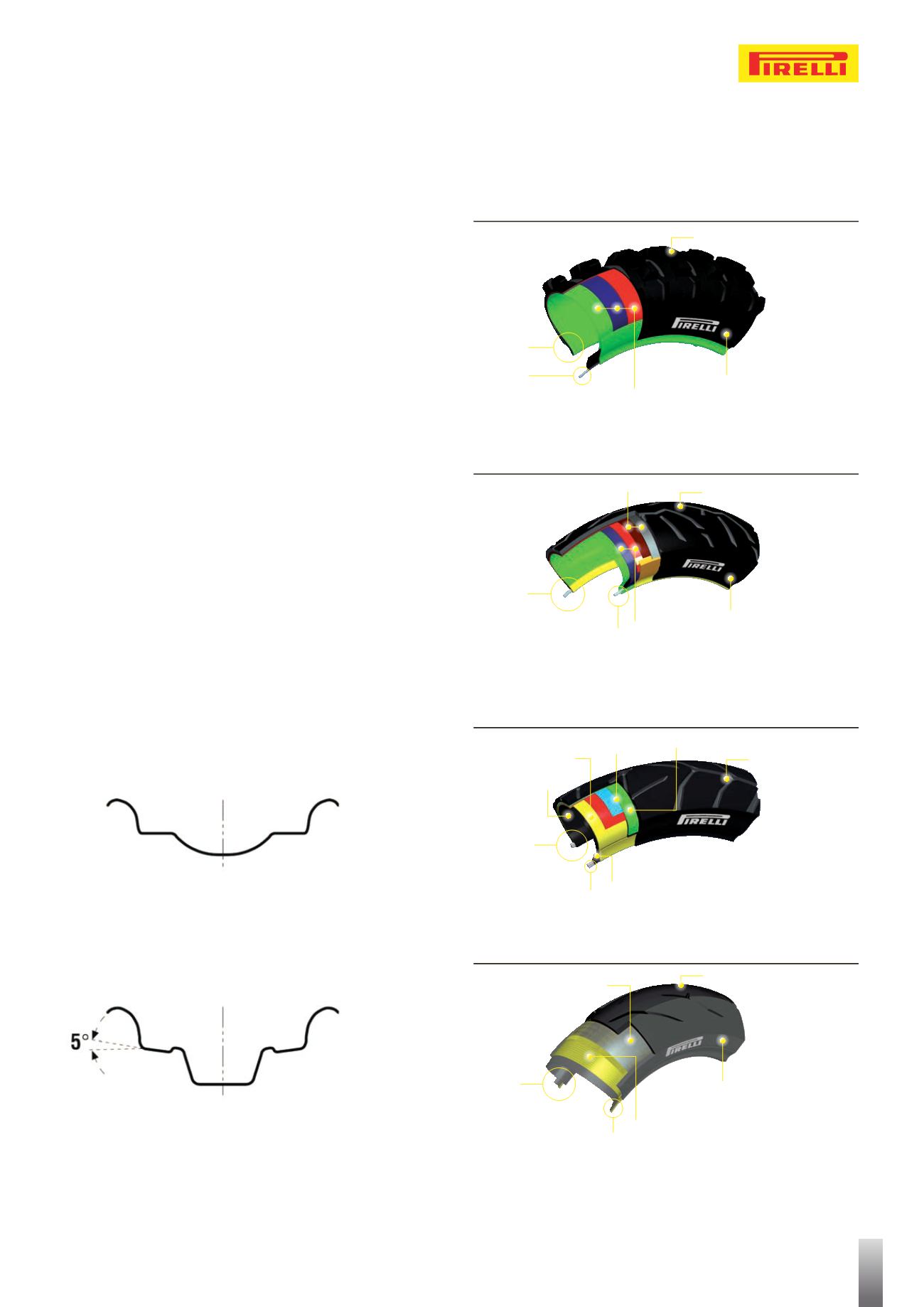

231
THE MOTORCYCLE TYRE
STRUCTURE AND CONSTRUCTION PRINCIPLES
As motorcycles have existed for over 100 years now their appearance has changed enormously. Modem
Superbikes of the 90 have a little in common with the bicycle type constructions of early motorcycles.
Only one part - the motorcycle tyre - has apparently remained the same to a lot of out siders. It is only
round and black!
But that Is not all. The modem radial tyres of PIRELLI are high-tech products and only the name motor-
cycle tyre and the black colour have anything in common with the tyres of 100 years ago. Below you will
find the various construction principles PIRELLI use today.
Each tyre, street, on-/off-road, moto cross, or scooter, has in general the following con struction cha-
racteristics:
TREAD PATTERN AND COMPOUND
The tread pattern Is the outer part of the tyre, in contact with the road.
The profile and rubber compound are chosen based on the use of the tyre. The rubber compound espe-
cially, requires a high level of experience and technical know-how. In general it can be said that with a
harder rubber compound mileage increases, and grip decreases. The softer the rubber compound, the
more grip a tyre has, but the mileage is reduced.
SIDEWALL
The sidewall is the „name plate“ of a tyre.The combinations of numbers and letters indicate not only the
name of the tyre but also the maximum speed and load allowed. In the transmission of circumferential
and side forces, as well as bump absorption the side wall plays an important role.
CARCASS
The carcass is the basis of the whole system and gives the tyre its form. The materials used are one or
more plies o Nylon or Rayon or Polyester. The main function of the carcass is to provide a flexible driving
forces from the bead to the tread.
BEAD
This is the component by which the tyre is fitted on the rim. It is reinforced by steel cores coated in rubber.
They aid in transmitting the accelerating and braking torques, as well as to mechanically connect the tyre
to the rim and to ensure against loss of inflation pressure.
THE MOST POPULAR MOTORCYCLE RIMS
Tube type WM
WM Contour.
Suitable for all PIRELLI tyres either tube or tubeless type.
Always a PIRELLI tube has to be used (even for tubeless tyres).
When using a tube in a PIRELLI tyre it has to be a PIRELLI tube.
MT H2 Contour
MT H2 Contour.
Suitable for all PIRELLI tyres either tube or tubeless type.
Recommendations of the bike manufacturer have to be observed.
When using a tube in a PIRELLI tyre it has to be a PIRELLI tube.
When using a tube in a PIRELLI tubeless tyre it has to be a PIRELLI tube.
When using a tube in a PIRELLI tubeless tyre it has to be a PIRELLI tube for all types of rims.
CAUTION: Maximum speed for “V” rated tubeless tyres used with a tube is 230 Km/h.
DIFFERENT CONSTRUCTION
The Motorcycle Tyre
CROSS PLY CONSTRUCION
BIAS BELTED CONSTRUCION
RADIAL CROSS BELTED
RADIAL CARCASS WITH ZERO DEGREE STEEL BELT
BELT PLY
TREAD
SIDEWALL
CARCASS PLY
BEAD WIRE
BEAD
TREAD
BEAD
BEAD WIRE
CARCASS PLY
SIDEWALL
BEAD
TREAD
BELT PLY
CARCASS
BEAD WIRE
BEAD FILLER
ADHESIVE PLATE
TUBELESS
INNER LINER
TREAD
BEAD
BEAD WIRE
SIDEWALL
90° CARCASS PLY
ZERO DEGREE STEEL BELT
Also indicated as conventional or x-ply tyre. Depending on the different speed and load specifications, the tyre carcass
is structured using two or more overlapping layers.
Each layer is made of rubber coated textile cords and the overlap angle is designed in order for the tyre to conform
with the required dynamic characteristics.
The structure consits of a conventional carcass and a belt made of two or more crossed layers.The difference
between the carcass and the belt is determined by the different goals they are designed to fulfill and consequently
different materials are used in the construction.
The belt is made mainly from Aramide and it’s function is to reduce the dynamic deformation caused by centrifugal
forces, while the carcass provides the tyre with its stiffness and load carrying capacity.
The main difference from the bias-belted construction is the structure of the carcass in this case is radial.This means
that its cords are wrapped radially around the tyre, from one bead to the other, giving big advantages in terms of
cornering stability, reduced weight and high-speed performance.
The patented technology enables the structure of both front and rear tyre to be achieved using a radial carcass and
a single layer belt made of steel. Depending on the rolling direction of the tyre, the belt is wound circumferentially
around the carcass giving an angle close to 0°.
The advantages of the use of steel are its extremely high rigidity and the possibility to tune the winding spacing thus
differentiating the stiffness distribution from shoulder to crown.


















